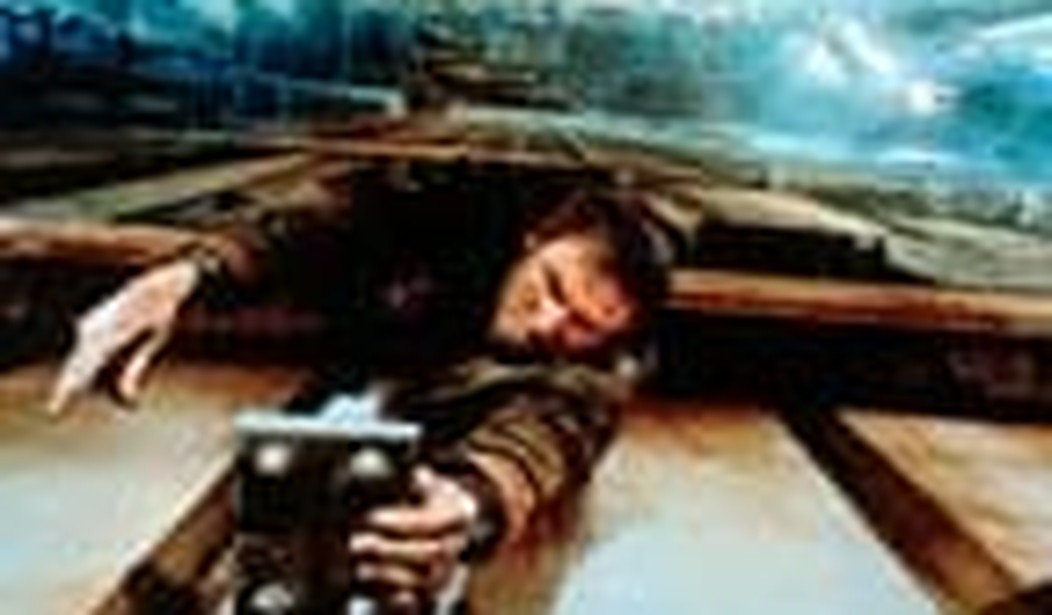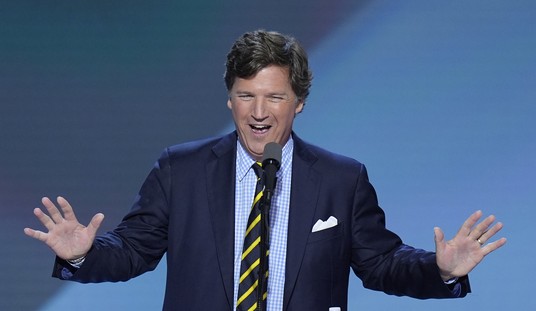We’re in the middle of a five-year Hollywood dry spell that’s so bad, one journalist even had the chutzpah to claim “The era of big cinema is over“. And in these days of what Mark Steyn calls “present-tense culture“, it may seem hard for many to remember that for forty years, Hollywood could be counted on to release at least one awe-inspiring science fiction film a decade. The trend began in the 1950s with Forbidden Planet, and its glimpse of the staggering artifacts left behind by that eponymic world’s long dead civilization, the Krell. 11 years later in 1968, Stanley Kubrick and Arthur C. Clarke gave the world 2001: A Space Odyssey, which presented audiences with not just The Dawn Of Man, but two of his possible successors: a space-born supercomputer named Hal, and rebirth as a Nietzschian starchild. In 1977, George Lucas would merge 1930s pulp with special effects inspired by 2001, and gave both movie audiences and the Hollywood industry itself A New Hope.
In 1999, The Matrix asked moviegoers to question reality itself, as it pondered a future in which the friends of Hal were running the show, and Man was literally nothing more than their batteries.
But The Matrix found its roots in the previous decade’s benchmark science fiction film, 1982’s Blade Runner.
License To Kill
After spending most of the 1970s working in the British advertising industry, Ridley Scott’s first film was The Duellists in 1977, a sort of road company version of Stanley Kubrick’s 1975 anti-epic, Barry Lyndon.
It garnered Scott much praise for its beautiful cinematography, but did little box office. It was with his next movie that Scott would hit the big time. For just as George Lucas had merged 1930s movie serials with cutting edge special effects in Star Wars, in Alien, Scott would take another old-time Hollywood staple, the bug-eyed horror-film monster, and move him into outer space.
Scott pushed all the right buttons of the massive audience for sci-fi that Star Wars cultivated just a couple of years earlier. And as a result of Alien’s box office success, he found himself at the point that a few successful directors reach. Movie studios gambling for their next hit will often give a suddenly hot director his one time license to kill, in the form of a big budget and a large amount of creative control. In the mid-1960s, Stanley Kubrick was given his by MGM as a result of Dr. Strangelove, and thus had both an enormous budget and the freedom to make 2001 into a film that was simultaneously a blockbuster and intensely personal. George Lucas was given his by 20th Century Fox after the low-budget American Graffiti minted big profits for Universal.
Star Wars’ happy ending and unambiguous black and white hatted characters revitalized a Hollywood that heretofore had spent the first three quarters of the 1970s alienating audiences with grim, nihilistic (but occasionally great) movies. Quickly becoming the highest grossing movie in Hollywood’s history, in its wake, the late 1970s and early 1980s was an era in which science fiction was the genre of choice in Tinseltown.
This was the environment in which Scott directed Blade Runner. The result was a film, much like 2001, that mystified early audiences, failed with its first critics, and yet slowly gathered cult status as one of its decade’s great cinematic achievements.
Blade Runner had so many offshoots that it created a whole cottage industry that throughout the 1980s routinely borrowed its design and story elements. TV’s Max Headroom and The Michael Keaton-era Batman movies borrowed its production design. The first Terminator movie from 1984 was little more than a way to tell the same story with a much lower budget by bringing the androids back to present-day L.A. And Jan Hammer’s gleaming synthesizer soundtrack to Miami Vice owes more than a small debt to the soundscape that synthesizer wizard Vangelis created for Blade Runner. In 1989’s Black Rain, even Ridley Scott himself ended the decade by trying to make present day Japan look like the L.A. he created seven years earlier.
Merging Man And Machine
But unlike much of what followed in its wake, what ties Blade Runner in with the elite science fiction films is its marriage of state-of-the-art special effects with a fully reasoned science fiction subtext. The Matrix’s postmodern “What is reality” theme is unthinkable without Blade Runner coming first-as Blade Runner asked, “what does it mean to be human?”
What the replicants actually are is deliberately left ambiguous by the filmmakers. They seem like the reverse of TV’s bionic characters-they appear to have artificial brains encased in human skin. They definitely bleed like humans when shot. But Rutger Hauer’s Roy Batty character certainly acts like he’s getting some sort of electrical short circuit when, Christ-like, he inserts a nail into the palm of his hand near the end of the film. But are they human? Well, they certainly pass the Turing test even better than Kubrick’s Hal 9000 does.
But who in the movie is human and who isn’t? In the original, 1982 version of Blade Runner, the notion that Harrison Ford’s Rick Deckard might be a replicant was certainly buried deep within the film’s subtext. Ten years later, for the film’s first Director’s Cut release, Scott inserted a brief scene that made the idea much less ambiguous. Coupled with the new ending of the film, it begged audiences to wonder: how much of Deckard’s back story-divorced hard bitten cop-was as manufactured as those of his female counterpart, played by Sean Young. While Ford was angry to suddenly find himself playing a robot, ex post facto, it provided the perfect sci-fi twist to end the movie.
Hiding A Multitude Of Sins
While the visual and sonic impact of the film was apparent from the start, the production design and killer music hide a few flaws: in the version of the film that went out to theaters in 1982, its continuity is just a mess. It’s somewhat understandable why Leonard Maltin, at least in the earlier versions of his annual Movie and Video Guide would write that the film is “a triumph of production design, defeated by a muddled script and main characters with no appeal whatsoever.”
Responding to less than stellar early previews, it’s obvious that Scott and the film’s producers tried to rescue the film in the editing room. That’s reflected in how so much expository information comes from actors when they’re off camera, particularly the police captain played by veteran character actor M. Emmett Walsh.
Walsh famously refers to “six replicants”, with one killed before the on-screen action began, ordering Ford’s character to find the remaining five. But the fifth replicant (apparently to be played by Stacy Nelkin, who was the inspiration for Mariel Hemingway’s character in Woody Allen’s Manhattan) was terminated by budget cuts long before her character could hit the streets of 21st century L.A.
The first shots of Rutger Hauer don’t match the scene that immediately follows, because they were stolen from the film’s last reel and dropped in to flesh out his character’s introduction. And then there was the original film’s incongruous drive off into the sunset happy ending, built around outtakes from the opening credits of Stanley Kubrick’s The Shining. At the time, critics complained that if the countryside is so much less developed than the city, why doesn’t everyone move there? (Probably for the same reason that contemporary Greenwich Village denizens rarely decamp to Texas or Iowa.)
We Call It Voight-Kampff For Short
As reflected in the five discs that are included in the new deluxe DVD edition of the film, Blade Runner went through a number of revisions, the most important of which were the film’s 1982 premiere, and 1992 “Director’s Cut” version. Although the latter jettisoned the happy ending and tacked on a lot of expository narration, it left all of the continuity errors from 1982 still very much present and accounted for.
Fortunately, through a combination of judicious sound editing and a handful of CGI shots to mask the limits of special effects in 1982, that’s all been cleaned up in a new DVD that promises it is the film’s “Final Cut”.
Just in time for Christmas, all of the film’s previous editions are included in the blow-out Gift Set DVD edition, which includes five DVDs packaged in a case resembling the Blade Runner squad’s replicant testing kit, the polygraph-like Voight-Kampff machine. There’s also some fun swag: a recreation of the symbolic origami unicorn that Edward James Olmos leaves in Deckert’s apartment at the end of the film, a toy “Spinner” flying police car, a portfolio of storyboards and a few of former Detroit automobile illustrator Syd Mead’s production design drawings.
Soylant Green II: Replicant Boogaloo
From the flying police cars to the film’s look of retrofitted technology within a moldering Los Angeles cityscape down and out underneath the film’s giant skyscrapers, Mead was responsible for much of the film’s look.
Mead’s brilliant designs, realized on film by an army of highly skilled cinematic technicians, mask perhaps Blade Runner’s biggest sin. It’s a film that, made by less skilled artists, could have fitted quite easily into the subgenre of sci-fi films that Star Wars happily helped put out to pasture: the sterile modernist Hollywood dystopian film. Think about it: replace Harrison Ford with Charlton Heston, ditch the noir lighting, clad the actors in white jumpsuits instead of ’40s-inspired togs, and replace Mead’s dank production design with clean Mies van der Rohe modernist architecture, and the plot of the film might have been too close for comfort to all of those early 1970s corporate-enviro-disaster movies. Without Ridley Scott, Syd Mead and Vangelis, Blade Runner would have been THX-1138 Again, Soylant Green II: Replicant Boogaloo or Rollerball: The Next Generation.
And in many ways, the film’s mindset is informed by the mindset of that era. It assumes a straight line from the urban hell of the 1970s to 2019, but we now know that it’s possible to stem much of that tide through policies such as Rudy Giuliani’s “Broken Window” school of law enforcement. And it assumes an overcrowded world, whereas Japan, the nation that’s likeliest to have a shot at something resembling replicants first, is building their human-shaped robots to offset the demographic decline and fall of a rapidly aging population reproducing far below the replacement rate.
But then, that’s another of science fiction’s hidden beauties: it often gives future generations looking back a more accurate picture of the people who created these films and their cultural obsessions, far better than it predicts the future itself.
Journalist/blogger Ed Driscoll produces PJM Political, Pajamas Media’s weekly show on XM Satellite radio.









Join the conversation as a VIP Member